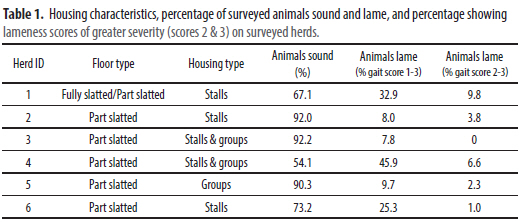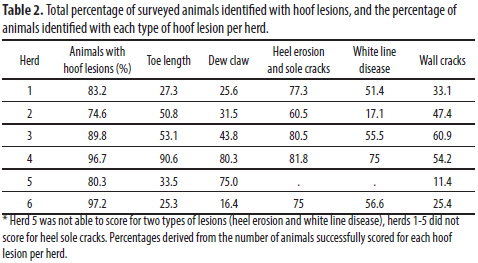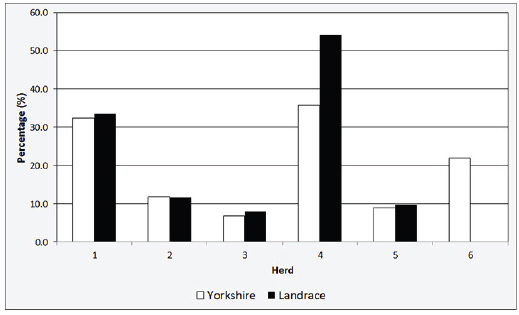



Quantifying the Prevalence of Lameness and Hoof Lesions in Canadian Nucleus Herds
A Canadian survey of genetic nucleus herds showed moderate levels of lameness and a high prevalence of hoof lesions, report Yolande Seddon and Jennifer Brown in the 2013-14 Annual Research Report from the Prairie Swine Centre in Canada. The authors comment that more objective methods of lameness evaluation are needed to monitor prevalence across herds effectively.Summary
The aim of this survey was to collect information on the prevalence of lameness and hoof lesions on genetic nucleus herds, to help provide baseline information on the prevalence of lameness and hoof lesions in Canadian sows. Six genetic herds were visited, located in Alberta, Saskatchewan, Manitoba, Ontario and Quebec.
Results found a wide variation in lameness across the herds, ranging from eight to 46 per cent. Combining data from all herds (1,139 sows in total), 20 per cent of sows showed signs of lameness. although much of this was mild, with only five per cent showing signs of more severe lameness.
In all barns surveyed, a high percentage of sows were observed with hoof lesions, with 74 to 97 per cent of animals affected. Heel erosion was the most common hoof lesion observed, being present in more than 50 per cent of sows in four barns.
These results suggest that leg and hoof health problems exist, and could be added to sow evaluation or selection criteria. The fact that some barns had much lower levels of lameness suggests that some herds may carry beneficial genetic traits that help reduce lameness.
The baseline information gathered from this survey presents useful information for industry and researchers alike, and demonstrates that greater emphasis may be needed on sow robustness, especially as group housing for sows becomes more common.
Further work to determine characteristics of sows with good leg health and hooves, along with genetic links related to leg and hoof health is of interest, and would help improve the welfare and longevity of sows, and aid in the development of more robust sows for use in group housing.
Introduction
Sow efficiency and longevity is of paramount importance to the profitability of swine operations. Genetic advances have come far, with modern sows able to produce large litter sizes and maintain a high level of production. However, lameness is a common problem among sows and a major reason for premature culling. Lameness is a painful condition and as such can influence the fertility, mobility, feed intake and longevity of sows in the herd.
*
"Results showed a large variation in lameness across herds, ranging from eight to 46 per cent."
Recent studies suggest that lameness in sows may be a larger problem than originally thought. The first quarterly report from the Canadian Swine Intelligence Health Network reports lameness as the second most frequent clinical diagnosis on pig farms (C. Byra personnal communication, 5 May 2014).
A lameness survey conducted by the Prairie Swine Centre on a 6,000-sow herd found that 54 per cent of sows showed signs of lameness, and of the sows identified as lame, 23 per cent were gilts and young sows (parities 0 to 3). Furthermore, 94 per cent of sows had hoof lesions, which are known to be detrimental to sow comfort and a route for infection entry. It is widely understood that lameness and hoof problems are multi-factorial, being influenced by factors in the environment, genetics, nutrition and management of the sow.
The current study surveyed six genetic nucleus herds to assess the prevalence of sow lameness and hoof condition within the Canadian breeding pyramid. Assessing the sow breeding pyramid is a valuable approach, as these animals are the source of commercial stock and their selection ultimately impacts productivity, sow health and well-being on all commercial farms. With the potential change from stall to group housing, now is a critical time carry out this quantitative survey. The survey results provide a benchmark and assessment training that will aid genetics companies in selecting animals suited to group housing systems, to ensure a ‘fit for purpose’ sow.
The objectives of this research were to survey herds within the Canadian swine genetic pyramid to:
- quantify the prevalence of lameness and hoof lesions in sows, and
- transfer practical knowledge to barn staff on the techniques for assessing lameness and hoof lesions.
Results and Discussion
Lameness
A representative sample was achieved at all sites, with data collected on 1,139 sows in total. Combing data from all herds, 20 per cent of sows surveyed were scored as lame (score 1-3). Across farms, there was a large variation in levels of lameness observed, ranging from 7.8 per cent to 45.9 per cent (Table 1). Potential sources of variation include differences in environment (floor type, slat width and placement), nutrition or genetics.

Individual variation among observers scoring on each farm also contributed to variation in the results. In particular, the assessment of lameness score 1 (indicating mild lameness) is open to subjective interpretation. Agreement on gait scores of 2 and 3 is typically much greater, as animals with pronounced lameness are much easier to identify. Therefore, the percentage of sows with gait scores of 2 and 3 is also included in Table 2, and still shows fairly high levels of lameness, with 9.8 per cent in herd 1 and 6.6 per cent in herd 4.

More objective measures of lameness are needed and will increase the reliability of results in future research. Of the two maternal breed lines studied per farm, it was found that lameness was similar between breeds on all farms, with the exception of farm 4, where a higher percentage was found in Landrace sows (Figure 1).

Note: Farm #6 held only one breed.
Hoof lesions
Hoof lesions were present in a high percentage of sows surveyed on all farms (Table 2). This result is similar to what has been reported in other studies. The prevalence of different types of lesions differed between barns, although some lesion types were prevalent throughout. Heel erosion was observed in a high percentage of sows in all barns, and white line disease affected over 50 per cent of surveyed sows in four barns. Mechanical factors such as the way the sow is standing, and the effects of flooring, in combination with inferior hoof horn growth is believed to contribute to both of these conditions. The severity of lesions was mild to moderate, with similar severity on the front and hind feet.
To the authors’ knowledge, this is the first study to gather lameness and hoof lesion data from multiple genetic nucleus herds. The level of lameness present is higher than may be considered acceptable, and across all herds suggests a 20 per cent level may exist within Canadian genetic herds. While the prevalence of more severe lameness was lower, ranging from zero to 10 per cent, this and the high prevalence of hoof lesions indicates a need for better understanding of the problem and indicates room for improvement. In particular, more research is needed on the genetic links between lameness and hoof lesions and their interaction with diet and flooring type.
This project also gathered information on the floor type and nutritional composition of feed provided to the animals. More in-depth analysis is needed before any interpretation can be given on how these factors are related to lameness or hoof lesions. However, the results so far suggest that even in nucleus herds, improvements can be made to reduce lameness and develop stock with greater robustness. If lameness is prevalent within genetic stock, managed with a high rate of sow turnover, it is likely to be found at equal or greater levels under commercial production conditions.
Conclusion
The results of this survey indicate that moderate levels of lameness exist within genetic nucleus herds, and suggests that selection could be done to improve the leg and hoof health of breeding stock. The information gathered from this survey provides an initial baseline that can increase our understanding of genetic factors related to lameness and hoof lesions. The gait and hoof lesion scoring protocols used in this project can be incorporated into selection criteria, allowing continued monitoring and promoting the development of sows with more desirable leg and hoof characteristics. In turn, this may produce a more robust sow that is better suited for group housing.
Acknowledgements: The authors gratefully acknowledge specific project funding for this study provided by the Canadian Agricultural Adaptation Program (CAAP). Strategic program funding to the Prairie Swine Centre was provided by Sask Pork, Alberta Pork, Manitoba Pork Council, Ontario Pork, and the Saskatchewan Agricultural Development Fund.
January 2015








